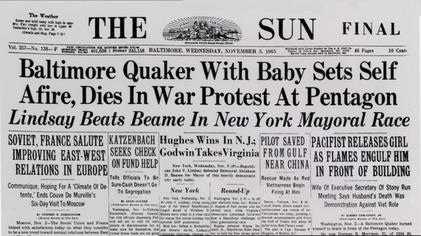Norman Morrison (December 29, 1933 – November 2, 1965), born in Erie, Pennsylvania, was a Baltimore Quaker best known for committing suicide at age 31 in an act of self-immolation to protest United States involvement in the Vietnam War.
Norman graduated from the College of Wooster in 1956.[1] He was married and had two daughters and a son.
On November 2, 1965, Morrison doused himself in kerosene and set himself on fire below Secretary of Defense Robert McNamara'sPentagon office.[2][3] This was probably in emulation of Buddhist monk Thich Quang Duc, who burned himself to death in downtown Saigon of then South Vietnam to protest the repression committed by the South Vietnam government.
Public response
Main article: List of political self-immolations
Filmmaker Errol Morris interviewed Secretary McNamara at length on camera in his documentary film, "The Fog of War." McNamara says, "[Morrison] came to the Pentagon, doused himself with gasoline. Burned himself to death below my office... his wife issued a very moving statement - 'human beings must stop killing other human beings' - and that's a belief that I shared, I shared it then, I believe it even more strongly today". McNamara then posits, "How much evil must we do in order to do good? We have certain ideals, certain responsibilities. Recognize that at times you will have to engage in evil, but minimize it." Perhaps the most detailed treatment of Morrison's death appears in "The Living and the Dead: Robert McNamara and Five Lives of a Lost War", by prizewinning author Paul Hendrickson, published in 1997.[4]
Morrison took his daughter Emily, then one year of age, to the Pentagon, and either set her down or handed her off to someone in the crowd before setting himself ablaze. Morrison's reasons for taking Emily are not entirely known. However, Morrison's wife later recalled, "Whether he thought of it that way or not, I think having Emily with him was a final and great comfort to Norman... [S]he was a powerful symbol of the children we were killing with our bombs and napalm--who didn't have parents to hold them in their arms."[5]
In a letter he mailed to his wife, Morrison reassured her of the faith in his act. "Know that I love thee," Morrison wrote, "but I must go to help the children of the priest's village." Robert McNamara described Morrison's death as "a tragedy not only for his family but also for me and the country. It was an outcry against the killing that was destroying the lives of so many Vietnamese and American youth." He was survived by his wife Anne Welsh and three children, Ben, Christina and Emily.[6]
Supporters portrayed Morrison as devoutly and sincerely sacrificing himself for a cause greater than himself. In Vietnam, Morrison quickly became a folk hero to some, his name rendered as Mo Ri Xon.[7] Five days after Morrison died Vietnamese poet Tố Hữu wrote a poem, Emily, My Child, assuming the voice of Morrison addressing his daughter Emily and telling her the reasons for his sacrifice.[8]North Vietnam named a Hanoi street after him, and issued a postage stamp in his honor. Possession of the stamp was prohibited in the US due to the US embargo against North Vietnam.
One week after Morrison, Roger Allen LaPorte performed a similar act in New York City, in front of the United Nations building. On May 9, 1967, as part of the start to the 1967 Pentagon camp-in, demonstrators held a vigil for Morrison, before occupying the Pentagon for four days until being removed and arrested.[citation needed]
Morrison's widow and two daughters (his son had died of cancer years earlier) visited Vietnam in 1999, where they met with Tố Hữu, the poet who had written the popular poem Emily, My Child. Anne Morrison Welsh recounts the visit and her husband's tragedy in her monograph, Fire of the Heart: Norman Morrison's Legacy In Vietnam And At Home.
On his visit to the United States in 2007, President of Vietnam Nguyễn Minh Triết visited a site on the Potomac near the place where Morrison immolated himself and read the poem by Tố Hữu to commemorate Morrison.[9]
Cultural depictions[edit]
Morrison's immolation is portrayed in the HBO film Path to War, in which he is portrayed by Victor Slezak.
In the Vietnamese city of Da Nang, a road is named after Norman Morrison in memory of his act against the Vietnam-U.S conflict. Parallel to it also is a road named after Francis Henry Loseby.
See also[edit]
- Alice Herz
- Brian Willson
- Florence Beaumont
- George Winne, Jr.
- List of political self-immolations
- Thích Quảng Đức
References[edit]
- ^ Wooster graduate immolated himself at the Pentagon in 1965 to protest the Vietnam War [1]
- ^ "The Pacifists" Time Magazine. November 12, 1965. (Accessed July 23, 2007) [2]
- ^ The Ultimate Protest; [FINAL Edition]
- ^ The Washington Post. Washington, D.C.: Nov 4, 1999. pg. C.14.
- ^ Grace Like a Balm, Sojourners Magazine/July-August 1995
- ^ Steinbach, Alice (July 30, 1995). "Quaker Sets Himself On Fire". The Baltimore Sun.
- ^ My Lai Peace Park website
- ^ Christian G. Appy (2008) Vietnam: the Definitive Oral History Told From All Sides. Ebury Press: 155
- ^ Thanh Tuấn (July 7, 2007). "Đọc thơ Tố Hữu bên bờ sông Potomac". Tuoi Tre. Retrieved 2007-07-07.
Further reading[edit]
Anne Morrison Welsh with Joyce Hollyday Held in the light: : One Man's Sacrifice for Peace and His Family's Search for Healing, Orbis 2008, ISBN 978-1-57075-802-7
External links[edit]
- Profile of Norman Morrison
- Sojourners interview with Anne Morrison Welsh, Morrison's widow
- [3], BBC interview with Anne Morrison Welsh, Morrison's widow, December, 2010
- Interview by John-Paul Flintoff with Anne Morrison Welsh, Morrison's widow in The Guardian (Family section) Saturday 16 October 2010, "I told them to be brave".
- Claus Bernet (2009). "Norman Morrison". In Bautz, Traugott. Biographisch-Bibliographisches Kirchenlexikon (BBKL) (in German)30. Nordhausen: Bautz. cols. 1023–1024. ISBN 978-3-88309-478-6.
|



No comments:
Post a Comment